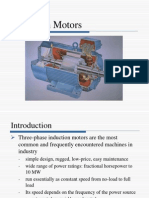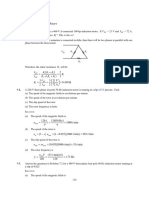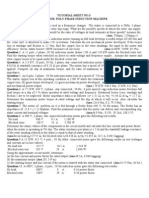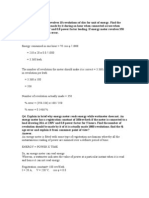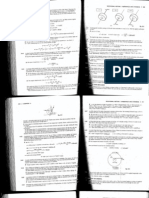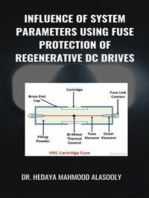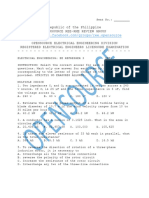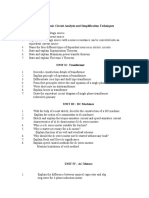0 ratings0% found this document useful (0 votes)
171 viewsChapter 23 Three-Phase Induction Motors
Chapter 23 Three-Phase Induction Motors
Uploaded by
isitestersThe document contains exercises related to three-phase induction motors. It includes questions about calculating synchronous speed, slip, torque, power output, efficiency and other motor parameters given information like number of poles, supply frequency, speed, losses etc. Detailed calculations are shown for each question.
Copyright:
© All Rights Reserved
Available Formats
Download as PDF, TXT or read online from Scribd
Chapter 23 Three-Phase Induction Motors
Chapter 23 Three-Phase Induction Motors
Uploaded by
isitesters0 ratings0% found this document useful (0 votes)
171 views9 pagesThe document contains exercises related to three-phase induction motors. It includes questions about calculating synchronous speed, slip, torque, power output, efficiency and other motor parameters given information like number of poles, supply frequency, speed, losses etc. Detailed calculations are shown for each question.
Original Description:
INDUCTION MOTORS Notes
Original Title
INDUCTION MOTORS
Copyright
© © All Rights Reserved
Available Formats
PDF, TXT or read online from Scribd
Share this document
Did you find this document useful?
Is this content inappropriate?
The document contains exercises related to three-phase induction motors. It includes questions about calculating synchronous speed, slip, torque, power output, efficiency and other motor parameters given information like number of poles, supply frequency, speed, losses etc. Detailed calculations are shown for each question.
Copyright:
© All Rights Reserved
Available Formats
Download as PDF, TXT or read online from Scribd
Download as pdf or txt
0 ratings0% found this document useful (0 votes)
171 views9 pagesChapter 23 Three-Phase Induction Motors
Chapter 23 Three-Phase Induction Motors
Uploaded by
isitestersThe document contains exercises related to three-phase induction motors. It includes questions about calculating synchronous speed, slip, torque, power output, efficiency and other motor parameters given information like number of poles, supply frequency, speed, losses etc. Detailed calculations are shown for each question.
Copyright:
© All Rights Reserved
Available Formats
Download as PDF, TXT or read online from Scribd
Download as pdf or txt
You are on page 1of 9
John Bird Published by Taylor and Francis 310
CHAPTER 23 THREE-PHASE INDUCTION MOTORS
Exercise 140, Page 393
1. The synchronous speed of a 3-phase, 4-pole induction motor is 60 rev/s. Determine the
frequency of the supply to the stator windings.
Synchronous speed,
s
f
n
p
= from which, frequency, f =
s
n p =
( )
4
60
2
! "
# $
% &
= 120 Hz
2. The synchronous speed of a 3-phase induction motor is 25 rev/s and the frequency of the supply
to the stator is 50 Hz. Calculate the equivalent number of pairs of poles of the motor.
s
f
n
p
= hence, number of pairs of poles, p =
s
f 50
n 25
= = 2
3. A 6-pole, 3-phase induction motor is connected to a 300 Hz supply. Determine the speed of
rotation of the magnetic field produced by the stator.
Speed of rotation,
s
f 300
n
6
p
2
= = = 100 rev/s
John Bird Published by Taylor and Francis 311
Exercise 141, Page 395
1. A 6-pole, 3-phase induction motor runs at 970 rev/min at a certain load. If the stator is connected
to a 50 Hz supply, find the percentage slip at this load.
Synchronous speed,
s
f 50 50
n
6
p 3
2
= = = = 16.667 rev/s
Rotor speed,
r
970
n
60
= = 16.167 rev/s
Hence, slip, s =
s r
s
n n 16.667 16.167
100% 100%
n 16.667
! " # # ! "
$ = $
% & % &
' (
' (
= 3%
2. A 3-phase, 50 Hz induction motor has 8 poles. If the full load slip is 2.5%, determine (a) the
synchronous speed, (b) the rotor speed, and (c) the frequency of the rotor e.m.f.s.
(a) Synchronous speed,
s
f 50
n
8
p
2
= = = 12.5 rev/s or 12.5 ! 60 = 750 rev/min
(b) Slip, s =
s r r
s
n n 12.5 n
100% i.e. 2.5 100%
n 12.5
! " # # ! "
$ = $
% & % &
' (
' (
i.e.
( )( )
r
2.5 12.5
12.5 n
100
= !
and rotor speed,
( )( )
r
2.5 12.5
n 12.5
100
= ! = 12.5 0.3125
= 12.1875 rev/s or 12.1875 ! 60 = 731 rev/min
(c) Since the synchronous speed is 12.5 rev/s and that of the rotor is 12.1876 rev/s, the rotating
magnetic field cuts the rotor bars at (12.5 12.1875), i.e. 0.3125 rev/s.
Thus, the frequency of e.m.f.s induced, f =
s
8
n p 0.3125
2
! = ! = 1.25 Hz
John Bird Published by Taylor and Francis 312
3. A three-phase induction motor is supplied from a 60 Hz supply and runs at 1710 rev/min when
the slip is 5%. Determine the synchronous speed.
Slip, s =
s r
s
n n
n
!
and the rotor speed,
r
1710
n
60
= = 28.5 rev/s
Hence,
s
s
n 28.5 5
100 n
!
=
and 0.05
s
n =
s
n - 28.5
i.e. 28.5 =
s
n - 0.05
s
n = 0.95
s
n
from which, synchronous speed,
s
n =
28.5
0.95
= 30 rev/s or 30 ! 60 = 1800 rev/min
4. A 4-pole, 3-phase, 50 Hz induction motor runs at 1440 rev/min at full load. Calculate (a) the
synchronous speed, (b) the slip and (c) the frequency of the rotor induced e.m.f.s.
(a) Synchronous speed,
s
f 50
n
4
p
2
= = = 25 rev/s or 25 ! 60 = 1500 rev/min
(b) Slip, s =
s r
s
n n
100%
n
! " #
$
% &
' (
where
r
1440
n
60
= = 24 rev/s
i.e. slip, s =
25 24 100
100%
25 25
! " #
$ =
% &
' (
= 4%
(c) n =
f
p
or frequency of the rotor induced e.m.f.s, f = n ! p = (25 24)
4
2
! "
# $
% &
= 2 Hz
John Bird Published by Taylor and Francis 313
Exercise 142, Page 396
1. A 12-pole, 3-phase, 50 Hz induction motor runs at 475 rev/min. Calculate (a) the slip speed,
(b) the percentage slip and (c) the frequency of the rotor currents.
(a) Synchronous speed,
s
f 50 50
n
12
p 6
2
= = = = 8.3333 rev/s
Rotor speed,
r
475
n
60
= = 7.9167 rev/s
Hence, slip speed =
s r
n n ! = 8.3333 7.9167 = 0.4166 rev/s = 0.4166 ! 60 = 25 rev/min
(b) Slip, s =
s r
s
n n 8.3333 7.9167
100% 100%
n 8.3333
! " # # ! "
$ = $
% & % &
' (
' (
= 5%
(c) Frequency of the rotor currents,
r
f sf 0.05 50 = = ! = 2.5 Hz
2. The frequency of the supply to the stator of a 6-pole induction motor is 50 Hz and the rotor
frequency is 2 Hz. Determine (a) the slip, and (b) the rotor speed in rev/min.
(a) Rotor frequency,
r
f sf = i.e. 2 = s(50)
from which, slip, s =
2
50
= 0.04 or 4%
(b) Slip, s =
s r
s
n n
n
! " #
$ %
& '
where
s
f 50 50
n
6
p 3
2
= = =
from which,
s s r
s n n n = !
and rotor speed,
( )
r s s s
50
n n s n n (1 s) 1 0.04
3
= ! = ! = !
= 16 rev/s or 16 ! 60 = 960 rev/min
John Bird Published by Taylor and Francis 314
Exercise 143, Page 398
1. The power supplied to a three-phase induction motor is 50 kW and the stator losses are 2 kW. If
the slip is 4%, determine (a) the rotor copper loss, (b) the mechanical power developed by the
rotor, (c) the output power of the motor if friction and windage losses are 1 kW, and (d) the
efficiency of the motor, neglecting rotor iron losses.
(a) Input power to rotor = stator input power stator losses
= 50 kW 2 kW = 48 kW
Slip =
rotor copper loss
rotor input
i.e.
4 rotor copper loss
100 48
=
from which, rotor copper loss = (0.04)(48) = 1.92 kW
(b) Total mechanical power developed by the rotor = rotor input power rotor losses
= 48 1.92 = 46.08 kW
(c) Output power of the motor = power developed by the rotor friction and windage losses
= 46.08 1 = 45.08 kW
(d) Efficiency,
output power 45.08
100% 100%
input power 50
! "
! "
#= $ = $
% & % &
' (
' (
= 90.16%
2. By using external rotor resistance, the speed of the induction motor in problem 1 is reduced to
40% of its synchronous speed. If the torque and stator losses are unchanged, calculate (a) the
rotor copper loss, and (b) the efficiency of the motor.
(a) Slip, s =
s r s s s
s s s
n n n 0.4n 0.6n
100% 100% 100%
n n n
! " ! " # #
$ = $ = $
% & % &
' ( ' (
= 60%
Input power to rotor = 48 kW
Since slip, s =
rotor copper loss
rotor input
then rotor copper loss = s (rotor input)
= 0.60(48) = 28.80 kW
John Bird Published by Taylor and Francis 315
(b) Power developed by rotor = input power to rotor rotor copper loss
= 48 28.80 = 19.20 kW
Output power of motor = power developed by rotor friction and windage losses
= 19.20 1 = 18.20 kW
Hence, efficiency of motor,
output power 18.20
100% 100%
input power 50
! "
! "
#= $ = $
% & % &
' (
' (
= 36.40%
John Bird Published by Taylor and Francis 316
Exercise 144, Page 400
1. A 400 V, three-phase, 50 Hz, 2-pole, star-connected induction motor runs at 48.5 rev/s on full
load. The rotor resistance and reactance per phase are 0.4 " and 4.0 " respectively, and the
effective rotor-stator turns ration is 0.8:1. Calculate (a) the synchronous speed, (b) the slip, (c) the
full load torque, (d) the power output if mechanical losses amount to 500 W, (e) the maximum
torque, (f) the speed at which maximum torque occurs, and (g) the starting torque.
(a) Synchronous speed,
s
f 50
n
2
p
2
= = = 50 rev/s or 3000 rev/min
(b) Slip, s =
s r
s
n n 50 48.5 1.5
n 50 50
! " # # ! "
= =
$ % $ %
& '
& '
= 0.03 or 3%
(c) Phase voltage,
1
400
E
3
= = 230.94 V
Full load torque, T =
( ) ( ) ( )
2
2
2 2 2
1 1 2
2 2 2
2
s
2 2
N
m
N s E R 3(0.8) 0.03(230.94) (0.4)
2 n 2 (50)
R s X 0.4 0.03 4.0
! "
# $
% &
' (
! " ! "
! "
% & ) *
= % & % &
% &
% &
+ +
+ + ,
% & % & - .
- . - .
% &
% &
- .
= (0.00611155)
639.9994
0.1744
! "
# $
% &
= 22.43 N m
(d) Output power, including friction losses,
m r
P 2 n T 2 (48.5)(22.43) = ! = ! = 6835 W
Hence, output power =
m
P - mechanical losses = 6835 500 = 6335 W or 6.34 kW
(e) Maximum torque occurs when
2 r
R X 0.4 = = !
Slip, s =
2
2
R 0.4
X 4.0
= = 0.1
Hence, maximum torque,
( )
( )
( ) ( )
2
2
1 2
m 2 2 2
2
2 2
0.01 230.94 0.4
s E R
T 0.00611155 (0.00611155)
0.4 0.4
R sX
! " ! "
= = # $ # $
# $ # $
+
+
% & % &
= (0.00611155)
2133.3331
0.32
! "
# $
% &
= 40.74 N m
John Bird Published by Taylor and Francis 317
(f) For maximum torque, slip, s = 0.1
Slip, s =
s r r
s
n n 50 n
i.e. 0.1
n 50
! " # # ! "
=
$ % $ %
& '
& '
i.e.
r
(0.1)(50) 50 n = ! and
r
n 50 (0.1)(50) = !
i.e. speed at which maximum torque occurs,
r
n 50 5 = ! = 45 rev/s or 2700 rev/min
(g) At the start, i.e. at standstill, slip, s = 1
Hence, starting torque =
( )
( )
( ) ( )
2
2
2 2
1 1 2
2 2 2
2
s
2 2
N
m
N E R (230.94) (0.4)
0.00611155
2 n
R X 0.4 4.0
! "
# $
% &
' (
! " ! "
% & ) *
= % & % &
% &
+
+ +
% & % &
, - , -
% &
% &
, -
= (0.00611155)
21333.31344
16.16
! "
# $
% &
= 8.07 N m
2. For the induction motor in Problem 1, calculate at full load (a) the rotor current, (b) the rotor
copper loss, and (c) the starting current.
(a) Rotor current,
( )
( )( )
( ) ( )
2
1
1
r
2 2 2
2
2 2
N
s E
0.03 0.8 230.94 N
5.54256
I
0.4176123
R sX 0.4 0.03 4.0
! "
# $
% &
= = =
' ( ' (
+ + )
* + * +
= 13.27 A
(b) Rotor copper loss per phase =
( ) ( )
2
2
r 2
I R 13.27 0.4 = = 70.44 W
Total rotor copper loss (for 3 phases) = 3 ! 70.44 = 211.3 W
(c) Starting current,
( )( )
2
1
1
2
2 2 2 2
2 2
N
E
0.8 230.94 N
I
R X 0.4 4.0
! "
# $
% &
= =
' ( ' ( + +
) * ) *
= 45.96 A
John Bird Published by Taylor and Francis 318
3. If the stator losses for the induction motor in Problem 1 are 525 W, calculate at full load (a) the
power input, (b) the efficiency of the motor and (c) the current taken from the supply if the motor
runs at a power factor of 0.84
(a) Output power,
m
P = 6835 W = 6.835 kW from (d) of problem 1
Rotor copper loss = 211.3 W = 0.2113 kW from (b) of problem 2
Stator input power,
1 m
P P rotor copper loss rotor stator loss = + +
= 6.833 + 0.2113 + 0.525 = 7.57 kW
(b) Net power output = 6.34 kW from (d) of problem 1
Hence, efficiency of motor,
output power 6.34
100% 100%
input power 7.57
! = " = " = 83.75%
(c) Power input,
1 L L
P 3V I cos = ! where cos # = power factor = 0.84
Hence, supply current,
( )( )
1
L
L
P 7.57 1000
I
3 V cos 3 400 0.84
!
= =
"
= 13.0 A
4. For the induction motor in Problem 1, determine the resistance of the rotor winding required for
maximum starting torque.
Rotor reactance,
r 2
X s X = and at starting, slip, s = 1
Maximum torque occurs when rotor resistance,
2 r 2 2
R X s X X = = = = 4.0 "
You might also like
- Final Exam Spring 2020Document7 pagesFinal Exam Spring 2020Irum SabaNo ratings yet
- Induction MachinesDocument81 pagesInduction Machinessandyarajagopalan321No ratings yet
- Electrical Design Calculations BookDocument121 pagesElectrical Design Calculations BookNurulazmi Bin Abd Rahman67% (3)
- Chapter 23Document10 pagesChapter 23Sherwin CaringalNo ratings yet
- Chapter 23 Three-Phase Induction MotorsDocument9 pagesChapter 23 Three-Phase Induction MotorsteweleNo ratings yet
- Induction Motor 330Document5 pagesInduction Motor 330amsee11No ratings yet
- Introduction To ELE Machine Work Sheet On Induction MotorDocument9 pagesIntroduction To ELE Machine Work Sheet On Induction MotorTSEGAAB NIGUSSENo ratings yet
- Chap 7 Solutions PDFDocument34 pagesChap 7 Solutions PDFIbrahim Hussain100% (1)
- Chapmanasenkron PDFDocument33 pagesChapmanasenkron PDFmuratNo ratings yet
- Transformer and Induction MotorDocument55 pagesTransformer and Induction MotorEldeen EscuadroNo ratings yet
- Panimalar Engineering College: Answer ALL Questions, Choose The Best Answer Part - A (30 X 1 30)Document6 pagesPanimalar Engineering College: Answer ALL Questions, Choose The Best Answer Part - A (30 X 1 30)sivaNo ratings yet
- 18037959Document5 pages18037959Gathy BrayohNo ratings yet
- Tutorial Induction Machine1Document3 pagesTutorial Induction Machine1nickokinyunyu11No ratings yet
- Test2see3433 QuestionDocument2 pagesTest2see3433 QuestionFizah Abdul RahmanNo ratings yet
- ET Tut7 AUT2017-18 PDFDocument3 pagesET Tut7 AUT2017-18 PDFMoulindu KunduNo ratings yet
- Chapter 7 Induction MotorsDocument34 pagesChapter 7 Induction MotorslalaNo ratings yet
- Mesin InduksiDocument40 pagesMesin InduksiZafid MaulanaNo ratings yet
- Chapter 4 SolutionsDocument5 pagesChapter 4 SolutionsTinozivasheNo ratings yet
- EEL203 Tutorial Test-III - Solutions PDFDocument6 pagesEEL203 Tutorial Test-III - Solutions PDFvammeenaNo ratings yet
- EPE3020 Sheet2 Fall2022Document4 pagesEPE3020 Sheet2 Fall2022Hassan SolimanNo ratings yet
- Ee321 Example-Asynchronous-Examples1-1Document3 pagesEe321 Example-Asynchronous-Examples1-1Paulo MoreiraNo ratings yet
- AC Rotating Machine MO'08Document5 pagesAC Rotating Machine MO'08Ank A DigItNo ratings yet
- EPO460 - Tutorial 4 - Induction MotorDocument3 pagesEPO460 - Tutorial 4 - Induction MotorTery YazidNo ratings yet
- IMDocument2 pagesIMMukesh SinghNo ratings yet
- Fitzgerald Chap 5 SolutionsDocument19 pagesFitzgerald Chap 5 SolutionsvainateyagoldarNo ratings yet
- Induction Motor TutorialDocument1 pageInduction Motor TutorialpramilachitraNo ratings yet
- Assignment 1: Electrical Machines-Ii (Elpc402)Document1 pageAssignment 1: Electrical Machines-Ii (Elpc402)Abishek BhardwajNo ratings yet
- AssignmentDocument9 pagesAssignmentsmart telugu guruNo ratings yet
- Tutorial - 6BEE - Transf+IndutionDocument3 pagesTutorial - 6BEE - Transf+IndutionPRAKHAR JHANo ratings yet
- Induction MotorDocument65 pagesInduction MotorAhmad Nawawi Ngah100% (1)
- Assignment Induction MotorsDocument3 pagesAssignment Induction MotorsMallikarjunBhiradeNo ratings yet
- Assignment 5 - Model AnswerDocument8 pagesAssignment 5 - Model Answerlwasd1234No ratings yet
- Tutorial 6 - Induction MotorDocument2 pagesTutorial 6 - Induction MotorMohdFirdausNo ratings yet
- Páginas Desde (Solutions Manual) Electric Machinery 6ed Fitzgerald, Kingsley, UmanDocument3 pagesPáginas Desde (Solutions Manual) Electric Machinery 6ed Fitzgerald, Kingsley, UmanPedro LopezNo ratings yet
- Problem Set Three PhaseDocument2 pagesProblem Set Three PhaseJomeNo ratings yet
- Ps 5Document1 pagePs 5Dawit B Melka100% (1)
- Speed Control of 3 Phase Induction Motor 1 Aim: Experiment No: 3Document10 pagesSpeed Control of 3 Phase Induction Motor 1 Aim: Experiment No: 3rohitkjNo ratings yet
- Tut 3Document3 pagesTut 3mohanrajgupta1950% (2)
- AssignmentDocument3 pagesAssignmentKevin HaleNo ratings yet
- Electric Macghinery QZ06 2015ADocument2 pagesElectric Macghinery QZ06 2015A謝益宏No ratings yet
- 3 - Induction Motor Tutorial SolutionsDocument5 pages3 - Induction Motor Tutorial SolutionsSeanNo ratings yet
- Induction Motors: The Concept of Rotor SlipDocument12 pagesInduction Motors: The Concept of Rotor Sliphafiz_jaaffarNo ratings yet
- 5.4 Rotor E.M.F and Frequency: Example 5.1: The Stator of A 3-Phase, 4-Pole Induction Motor IsDocument6 pages5.4 Rotor E.M.F and Frequency: Example 5.1: The Stator of A 3-Phase, 4-Pole Induction Motor IsJOHN MINKHANTNo ratings yet
- ET Tut7 AUT2017-18Document2 pagesET Tut7 AUT2017-18raviNo ratings yet
- Lista de Ejercicios 5a - Intro - Máquinas de InducciónDocument3 pagesLista de Ejercicios 5a - Intro - Máquinas de InducciónStiven Garcia BedoyaNo ratings yet
- Numerical Problems Induction MotorsDocument3 pagesNumerical Problems Induction Motorsloke06235100% (2)
- Practice ProblemsDocument4 pagesPractice Problemsdragon_warrior112456804No ratings yet
- حل اسئلة الفصل الثاني مكائن مستمرةDocument4 pagesحل اسئلة الفصل الثاني مكائن مستمرةSetrax .sNo ratings yet
- Electrical Machines Tutorial Questions On Induction MachineDocument2 pagesElectrical Machines Tutorial Questions On Induction Machinejosenit1787No ratings yet
- SheetDocument2 pagesSheetkhaledlkhamisyNo ratings yet
- Tutorial 9 Induction Motors IDocument2 pagesTutorial 9 Induction Motors IAkshat SharmaNo ratings yet
- Electrical InstrumentsDocument19 pagesElectrical InstrumentsLakshmi Priya Palaniappan100% (1)
- Rotational Kinematics Problems and SolutionsDocument9 pagesRotational Kinematics Problems and SolutionsBen CampanaroNo ratings yet
- SM Examples and SolutionsSynchronous MachinesDocument16 pagesSM Examples and SolutionsSynchronous MachinesRacheal KirbyNo ratings yet
- EE 312 - Tutorial 1Document2 pagesEE 312 - Tutorial 1Abdallah JongoNo ratings yet
- Solucion Cap 4 ChapmanDocument6 pagesSolucion Cap 4 ChapmanEduardo Llanos CruzNo ratings yet
- Advanced Electric Drives: Analysis, Control, and Modeling Using MATLAB / SimulinkFrom EverandAdvanced Electric Drives: Analysis, Control, and Modeling Using MATLAB / SimulinkNo ratings yet
- Electricity in Fish Research and Management: Theory and PracticeFrom EverandElectricity in Fish Research and Management: Theory and PracticeNo ratings yet
- Influence of System Parameters Using Fuse Protection of Regenerative DC DrivesFrom EverandInfluence of System Parameters Using Fuse Protection of Regenerative DC DrivesNo ratings yet
- Power System Transient Analysis: Theory and Practice using Simulation Programs (ATP-EMTP)From EverandPower System Transient Analysis: Theory and Practice using Simulation Programs (ATP-EMTP)No ratings yet
- CatalogueDocument88 pagesCatalogueTimofteDanielNo ratings yet
- Course Structure of B.Sc. Food Technology Semester I S.No. Course Code Name of The Course CreditsDocument80 pagesCourse Structure of B.Sc. Food Technology Semester I S.No. Course Code Name of The Course CreditsA RahmanNo ratings yet
- VVVF FrenicDocument32 pagesVVVF FrenicElevator & Escalator EngineeringNo ratings yet
- PMM OperaciónDocument2 pagesPMM OperaciónLeon PerezNo ratings yet
- WFC 4000Document64 pagesWFC 4000Cesar PolancoNo ratings yet
- Electrical ScienceDocument59 pagesElectrical ScienceSk.Abdul NaveedNo ratings yet
- Acces Point - Ee Refresher 3Document10 pagesAcces Point - Ee Refresher 3christinesarah0925No ratings yet
- EPE491 Single-Phase MotorsDocument11 pagesEPE491 Single-Phase MotorsAliMubarakNo ratings yet
- Questin BankDocument23 pagesQuestin Bankayushpathak.mailNo ratings yet
- UNITWISE QUESTION BANK Be3251Document3 pagesUNITWISE QUESTION BANK Be3251siva sankari PNo ratings yet
- EEEB413 Electro-Mechanical SystemsDocument45 pagesEEEB413 Electro-Mechanical SystemsLynda909No ratings yet
- QUESTION BANK Basic Electrical EngineeringDocument7 pagesQUESTION BANK Basic Electrical EngineeringChirag Shakya100% (1)
- Gate 2019 Online Test SeriesDocument6 pagesGate 2019 Online Test SeriesBhoopendra SinghNo ratings yet
- 1 Motor 2 eDocument42 pages1 Motor 2 eUsman NasrullahNo ratings yet
- 7.1.1 CLIVET-Magnetic Centrifugal ChillerDocument26 pages7.1.1 CLIVET-Magnetic Centrifugal Chillerirwantino susiloNo ratings yet
- Induction Motor - Double Field Revolving Theory - Universal MotorDocument24 pagesInduction Motor - Double Field Revolving Theory - Universal MotorSree ShobhaNo ratings yet
- 150 Cau Hoi Trac Nghiem On TapDocument37 pages150 Cau Hoi Trac Nghiem On TapKim NhàngNo ratings yet
- Uniti:: Unit I:Basic Circuit Analysis and Simplification TechniquesDocument2 pagesUniti:: Unit I:Basic Circuit Analysis and Simplification TechniquesymeghnaNo ratings yet
- EV3200 Manual InstructionDocument25 pagesEV3200 Manual InstructionHuy Nhut Ele VatorNo ratings yet
- WEG Soft Starter Manual Usass11 Brochure English PDFDocument232 pagesWEG Soft Starter Manual Usass11 Brochure English PDFsharan87No ratings yet
- c8 PDFDocument64 pagesc8 PDFAnjaana PrashantNo ratings yet
- AssignmentDocument9 pagesAssignmentsmart telugu guruNo ratings yet
- Design and Performance Analysis of A Universal Motor For Industrial Alarm SystemsDocument5 pagesDesign and Performance Analysis of A Universal Motor For Industrial Alarm SystemsNoel BactonNo ratings yet
- Tutorial-I Converter Fed DC Motor Drive Problems 1Document10 pagesTutorial-I Converter Fed DC Motor Drive Problems 1siva kumarNo ratings yet
- Three Phase AC Motor and Three Phase Synchronous MotorDocument2 pagesThree Phase AC Motor and Three Phase Synchronous MotorgenesisjohnhleysaNo ratings yet
- 26 05 83 10 (16221)Document14 pages26 05 83 10 (16221)Nhan HuynhNo ratings yet
- Medium High MotorsDocument20 pagesMedium High Motorsshcoway100% (1)
- EER-Motor NotificationDocument2 pagesEER-Motor NotificationMahmoud NoureldinNo ratings yet
- Synchronous Generator or Alternator: Sikandar Ali KhanDocument157 pagesSynchronous Generator or Alternator: Sikandar Ali KhanAaryaveerNo ratings yet

